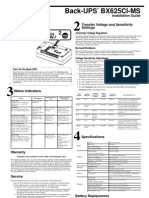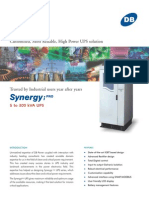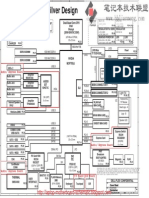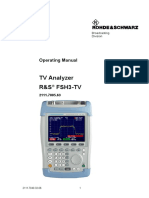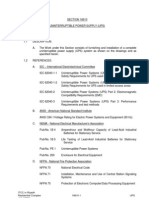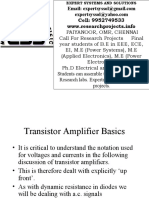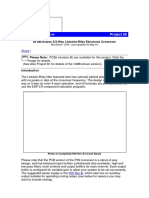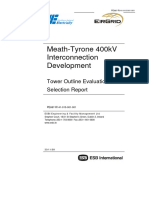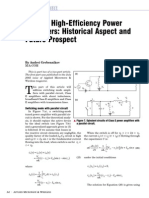Mge Galaxy 5000 PDF
Mge Galaxy 5000 PDF
Uploaded by
Ngoy mulundaCopyright:
Available Formats
Mge Galaxy 5000 PDF
Mge Galaxy 5000 PDF
Uploaded by
Ngoy mulundaOriginal Title
Copyright
Available Formats
Share this document
Did you find this document useful?
Is this content inappropriate?
Copyright:
Available Formats
Mge Galaxy 5000 PDF
Mge Galaxy 5000 PDF
Uploaded by
Ngoy mulundaCopyright:
Available Formats
APC by Schneider Electric
MGE GALAXY 5000
Data Center Grade Three Phase Uninterruptible Power Supply
Parallel Module - Guide Specifications
40-130 kVA UPS
1.0 GENERAL
1.1 SUMMARY
This specification describes a three-phase, on-line, double conversion, solid state Uninterruptible
Power System hereafter referred to as the UPS. The UPS shall operate in conjunction with the
existing building electrical system to provide high quality power conditioning, back-up power
protection and distribution for electronic equipment loads. The system shall consist of a solid state
IGBT rectifier/inverter, power factor corrected rectifier, a 100% rated for continuous duty static
switch, battery plant, graphical status/control panel, and synchronizing circuitry as described herein.
1.2 STANDARDS
The UPS shall meet the requirements of the following standards:
A. UL listed under 1778, standards for uninterruptible power supply equipment
B. UL Canada (cUL)
C. FCC rules and regulations of part 15, subpart J, class A
D. IEC 1004/ANSI C62.41 Standards for Surge Withstand Ability
E. ISO 9001
F. The UPS shall be designed in accordance with the applicable sections of the documents
published by:
National Fire Protection Association (NFPA)/National Electric Code (NEC)
National Electrical Manufacturer’s Association (NEMA) & (NEMA PE 1)
Occupational Safety & Health Administration (OSHA)
1.3 SUBMITTALS
Submittals shall contain the following documentation:
A. Installation Package: Complete electrical characteristics and connection requirements.
Provide detailed equipment outlines with cabinet dimensions and spacing requirements;
location of conduit entry/exit paths; location of floor/seismic mounting; available battery
types/sizes; all cabinet weights; heat rejection and air flow requirements; single-line diagram;
control and external wiring.
B. Product Data: Provide catalog sheets and technical data sheets to indicate physical data and
electrical performance, electrical characteristics, and connection requirements.
C. Manufacturer’s Installation Instructions: Indicate application conditions and limitations of
use stipulated by Product testing agency. Include instructions for storage, handling, protection,
examination, preparation, installation, and starting of Product. Include equipment installation
APC – MGE Galaxy 5000 Specification (60Hz) 1 Effective: June 1, 2008 REV X0 JJG
Parallel Module
Great user manuals database on UserManuals.info
outline, connection diagram for external cabling, internal wiring diagram, and written instruction
for installation.
1.4 FINAL SUBMITTALS
Upon delivery of the UPS system the following submittals shall be included:
A. A complete set of installation drawings showing all the information stated in section 1.3.
B. An installation and users manual showing safe and correct operation of all UPS functions.
1.5 QUALIFICATIONS & QUALITY ASSURANCE
A. Manufacturer’s Certification: The manufacturer shall specialize in manufacturing of on-line,
double conversion three phase UPS modules specified in this document with a minimum of
twenty years documented experience, and with a nationwide first party service organization.
The manufacturer shall be ISO 9001 certified and shall design to internationally accepted
standards.
B. Factory Testing: Prior to shipment the manufacturer shall complete a documented test
procedure to test all functions of the UPS module and batteries (via a discharge test), when
supplied by the UPS manufacturer, and guarantee compliance with the specification. The
factory test shall be performed in the presence of the customer providing the manufacturer
receives adequate prior notice. The manufacturer shall provide a copy of the test report upon
request.
C. Materials and Assemblies: All materials and parts comprising the UPS shall be new, of
current manufacture, and shall not have been in prior service, except as required during factory
testing. All active electronic devices shall be solid state and not exceed the manufacturer’s
recommended tolerances for temperature or current to ensure maximum reliability. All
semiconductor devices shall be sealed. All relays shall be provided with dust covers. The
manufacturer shall conduct inspections on incoming parts, modular assemblies, and final
products.
1.6 DELIVERY, STORAGE, AND HANDLING
A. All products shall be packaged in a manner to prevent penetration by debris and to allow safe
delivery by all modes of ground transportation and air transportation where specified.
B. Prior to shipping all products shall be inspected at the factory for damage.
C. Equipment shall be protected against extreme temperature and humidity and shall be stored in
a conditioned or protected environment.
D. Equipment containing batteries shall not be stored for a period exceeding three months without
powering up the equipment for a period of eight hours to recharge the batteries.
1.7 ENVIRONMENTAL REQUIREMENTS
The UPS shall operate under the following environmental conditions:
A. Temperature:
APC – MGE Galaxy 5000 Specification (60Hz) 2 Effective: June 1, 2008 REV X0 JJG
Parallel Module
Great user manuals database on UserManuals.info
UPS Module Operating: 0° to 40°C (32°F to 104°F)
Non-Operating: -20° to +45°C (-4°F to 113°F)
B. Relative humidity (operating and storage): 0 to 95% non-condensing
C. Barometric Pressure: Up to 1000 meters above sea level (up to 2000 meters with
ambient temperature less than 28°C) / (up to 12,000 meters above sea level non operating)
D. Audible Noise: 69 dBA at 3 feet
1.8 WARRANTY
A. UPS Module: The UPS shall be covered by a full parts and labor warranty from the
manufacturer for a period of twelve (12) months from date of installation or acceptance by
customer or eighteen (18) months from date of shipment from the manufacturer, whichever
occurs first.
B. Battery: The battery manufacturer’s warranty shall be passed through to the final customer and
shall have a minimum period of one year.
1.9 SERVICE AND SPARE PARTS
The manufacturer shall, upon request, provide spare parts kits for the UPS module in a timely
manner as well as provide access to qualified factory trained first party service personnel to provide
preventative maintenance and service on the UPS module when required.
1.10 MAINTENANCE, ACCESSIBILITY AND SELF DIAGNOSTICS
All UPS subassemblies, as well as the battery, shall be accessible from the front. UPS design
shall provide maximum reliability and minimum MTTR (mean time to repair). To that end, the
UPS shall be equipped with a self-test function to verify correct system operation. The self-test
function shall identify the subassembly requiring repair in the event of a fault. The electronic UPS
control and monitoring assembly shall therefore be fully microprocessor based, thus doing away
with all potentiometer settings. This shall allow:
Auto-compensation of component drift;
Self-adjustment of replaced subassemblies;
Extensive acquisition of information vital for computer-aided diagnostics (local or remote);
Socket connection to interface with computer-aided diagnostics system.
The UPS shall be repairable by replacing standard subassemblies requiring no adjustments.
Communication via a modem with a remote maintenance system shall be possible.
2.0 PRODUCT DESCRIPTION
2.1 APPROVED MANUFACTURERS & PRODUCT DESCRIPTION
A. Approved Manufacturer(s): The specified equipment will be manufactured by APC by
Schneider Electric or approved manufacturer in compliance with specifications.
B. Product Description: This specification describes a three-phase, double conversion, on-line,
solid state Uninterruptible Power System, hereafter referred to as the UPS. The UPS shall
operate in conjunction with the existing building electrical system to provide power conditioning,
back-up power protection and distribution for electronic equipment loads. The system shall
consist of a solid state IGBT PWM inverter, IGBT rectifier with a power factor corrected input,
APC – MGE Galaxy 5000 Specification (60Hz) 3 Effective: June 1, 2008 REV X0 JJG
Parallel Module
Great user manuals database on UserManuals.info
static switch, battery plant, graphical status/control panel, dry contact and communications
ports, and synchronizing circuitry as described herein.
2.2 SYSTEM DESCRIPTION
A. UPS Design Requirements
1. Output Power Continuous Rating: The continuous output power rating of the UPS shall
be [ ] kVA at a 0.9 lagging power factor.
Galaxy 5000 available: Choose 40, 50, 60, 80, 100, 130kVA
2. Input Voltage: 480 VAC – 15% / +10%, 3 phase, 3 wire “grounded wye” configuration
plus ground.
3. Output voltage: 480 VAC 3 phase, 3 plus ground
4. Battery Autonomy: The UPS shall be capable of operating at full load for [ ] minutes at
0.9 PF output at a temperature of 25°C on battery power.
5. Battery Type: Valve regulated sealed lead acid (VRLA)
B. AC Input Characteristics
1. Voltage: 480VAC, – 15% / +10%, 3 phase, 3 wire “grounded wye” configuration plus
ground.
2. Frequency: 60 Hz ±5%
3. Power Factor: > .98 lagging
4. Total Harmonic Distortion: less than 5% at full load
5. Inrush Current: less than nominal input current for less than one cycle
6. Input Surge Protection: The UPS is equipped to withstand surges per IEC 1004/ANSI
C62.41
C. AC Output Characteristics
1. Voltage: 480VAC , – /+ 1% steady-state variation phase to phase voltage VAC , 3 phase,
3 wire plus ground
2. Frequency: 60 Hz +1% (or selectable up to 4%); 60 Hz + 0.1% when free running
3. Voltage Regulation: + 1.0% for balanced load
+ 1.75 for 50% unbalanced load
+ 2.5% for 100% unbalanced load
4. Voltage Distortion: Maximum 2% total (THD) and 1% any single harmonic on 100% linear
loads.
5. Voltage Transient (Step Load) Response: + 3% for 50% step load change
+ 5% for 100% step load change
APC – MGE Galaxy 5000 Specification (60Hz) 4 Effective: June 1, 2008 REV X0 JJG
Parallel Module
Great user manuals database on UserManuals.info
+ 1% for loss or return of AC input power or
manual transfer at full load
6. Voltage Recovery Time: Return to within 1% of nominal value within 16.67 milliseconds
(one cycle)
7. Phase Angle Displacement: 120° + 1° for balanced load; 120° + 3° for 100% unbalanced
load
8. Non-Linear Load Capability: Output voltage total harmonic distortion shall be less than
3% when connected to a 100% non-linear load with a crest factor not to exceed 3%.
9. Slew Rate: 1 Hz/second maximum (or selectable up to 2.0 Hz/sec)
10. Power Factor: 0.9 at the rated volt-amperes (VA)
11. Inverter Overload Capability: 125% of rated load for 10 minutes
150% of rated load for 1 minute
12. Bypass Overload Capability: > 212% for one cycle; > 150% for 1 minute
D. Battery
1. Battery Voltage: 356 VDC minimum before cutoff; 432 VDC nominal; 490 VDC
equalization voltage
2. Maximum DC Current: Maximum DC current at cutoff voltage will be [ ] A.
2.3 MODES OF OPERATION
The UPS module shall be designed to operate as a double conversion, on-line reverse transfer
system in the following modes.
A. Normal: The inverter shall continuously supply power to the critical load. The PFC rectifier shall
derive power from the utility AC source and supply DC power to the inverter while
simultaneously float charging the battery.
B. Emergency: Upon failure of the utility AC power source, the critical load shall be supplied by
the inverter, which, without any interruption, shall obtain its power from the battery.
C. Recharge: Upon restoration of the utility AC power source (prior to complete battery discharge),
the PFC rectifier shall power the inverter and simultaneously recharge the battery.
D. Bypass Mode: The static bypass transfer switch shall be used to transfer the load to the
bypass without interruption to the critical power load. This shall be accomplished by turning the
inverter off. Automatic re-transfer or forward transfer of the load shall be accomplished by
turning the inverter on.
2.4 COMPONENT DESCRIPTION
A. PFC Rectifier and Battery Charger
APC – MGE Galaxy 5000 Specification (60Hz) 5 Effective: June 1, 2008 REV X0 JJG
Parallel Module
Great user manuals database on UserManuals.info
Incoming AC power shall be converted to a regulated DC output voltage by an IGBT
(insulated gate bipolar transistor) power factor correction (PFC) rectifier. The PFC rectifier
shall provide high quality DC power to charge the batteries and power the inverter and shall
have the following characteristics:
1. Input Power Factor Correction (PFC): The PFC rectifier shall be power factor
corrected so as to maintain an input power factor of 0.98 lagging to unity at 75% or above
load levels to ensure generator compatibility and avoid reflected harmonics from
disturbing loads sharing the utility power.
2. Input Harmonic Current Suppression: The PFC rectifier shall produce a sinusoidal
input AC current on each phase with low harmonic content, limiting THD on the UPS
input to below 5%.
3. Battery Charger Current Limiting: The UPS shall be equipped with a system designed
to limit the battery recharge current (from 0.05 C10 to 0.1 C10).
4. Charging Levels: The battery charging circuitry shall be capable of being set for
automatic battery recharge operation, float service, manual battery charge service, and
equalizing or commissioning operation.
5. Intermittent Charging: The battery charge level shall be maintained by an intermittent
charging technique between two values Vfmin and Vfmax very close to the floating
voltage. This technique shall be based on a cycle made up of a short charge period (a
few seconds) from Vfmin to Vfmax followed automatically by a slow discharge period (a
few minutes) from Vfmax to Vfmin. This cycle shall be repeated continuously to maintain
the battery charge level. In this way the battery shall actually be charging only for a small
part of the time, which considerably increases its service life.
6. Temperature Compensated Charging: The battery charger shall be equipped with a
temperature probe to enable temperature compensated charging and adjust the battery
float voltage to compensate for the ambient temperature using a negative temperature
coefficient of 3 mV per cell per degree Celsius at a nominal temperature of 25°C.
7. Battery Capacity: The battery charger shall have sufficient capacity to support a fully
loaded inverter and fully recharge the battery to 95% of its full capacity within 6-8 hours
up to 4 battery cabinets..
B. Inverter
The UPS output shall be derived from a Variable Frequency Pulse Width Modulated (PWM)
IGBT inverter design. The inverter shall be capable of providing the specified precise output
power characteristics while operating over the battery voltage range.
C. Static Bypass – 100% Rated, Continuous Duty
The static bypass transfer switch shall be solid-state, rated for 100% continuous duty without
mechanical contactor device in parallel for higher reliability and consistent response time and
shall operate under the following conditions:
APC – MGE Galaxy 5000 Specification (60Hz) 6 Effective: June 1, 2008 REV X0 JJG
Parallel Module
Great user manuals database on UserManuals.info
1. Uninterrupted Transfer: The static bypass transfer switch shall automatically cause the
bypass source to assume the critical load without interruption after the logic senses one of
the following conditions:
a) Inverter overload exceeds unit's rating
b) Battery protection period expired and bypass current is available
c) Inverter failure
2. Interrupted Transfer: If the bypass source is beyond the conditions stated below, the UPS
will make an interrupted transfer (not less than 100 mSec in duration).
a) Bypass voltage greater than + 10%, -10% from the UPS rated output voltage.
b) Bypass frequency greater than + 2 Hz from the UPS rated output frequency.
3. Automatic Uninterrupted Forward Transfer: The static bypass transfer switch shall
automatically forward transfer power, without interruption, after the UPS inverter is turned
"ON" after an instantaneous overload-induced reverse transfer has occurred and the load
current returns the UPS’s nominal rating or less.
4. Manual Transfer: A manual static transfer shall be initiated from the UPS Control Panel by
turning the UPS inverter off.
5. Overload Ratings: The static bypass transfer switch shall have the following overload
characteristics:
a) 1000% of UPS output rating for 0.016 seconds (one cycle)
b) 150% for 1 minute
c) 125% of UPS for 10 minutes
D. Output Static Switch – 100% Rated, Continuous Duty
UPS output shall be equipped with a 100% rated output static switch without mechanical
contactor device in parallel for higher reliability and consistent response time of 16.66 msec.
3.0 SYSTEM CONTROLS AND INDICATORS
A. Microprocessor Controlled Logic
• The full UPS operation shall be provided through the use of microprocessor controlled
logic. All operation and parameters are firmware controlled, thus eliminating the need for
manual adjustments or potentiometers. The logic shall include a self-test and diagnostic
circuitry such that a fault can be isolated down to the printed circuit assembly or plug-in
power assembly level. Every printed circuit assembly or plug-in power assembly shall be
monitored. Diagnostics shall be performed via a PC through the local diagnostics port on
the UPS. UPS shall be microprocessor controlled
• The UPS will include a standard easy to use control and indicator panel. Included will be
a backlit, color graphic animated LCD display and LED indicators. The UPS panel will
include UPS “ON” and UPS “OFF” pushbuttons that will permit the user to safely
command the UPS on or off without risk of load loss.
• Display shall facilitate operation by offering the functions listed below.
o Operating information supplied on the screens.
APC – MGE Galaxy 5000 Specification (60Hz) 7 Effective: June 1, 2008 REV X0 JJG
Parallel Module
Great user manuals database on UserManuals.info
o The graphic display shall assist the user by providing step by step help in the
user's language.
o LED mimic diagram
o The mimic diagram shall enable display of installation parameters, configuration,
operating status and alarms and indication of operator instructions for switching
operations (e.g. bypass).
o It shall be possible to display the following measurements:
inverter output phase-to-phase voltages;
inverter output currents;
inverter output frequency;
voltage across battery bank;
battery charge or discharge current;
rectifier/charger input phase-to-phase voltages;
rectifier/charger input currents;
active and apparent power;
power factor of the load;
battery temperature.
display of status conditions and events
o It shall be possible to display the following indications:
load on battery power;
load on UPS;
load on automatic bypass;
general alarm;
battery fault;
remaining battery backup time;
low battery warning;
bypass AC source outside tolerances;
o Additional information shall be provided in view of accelerating servicing of the
system.
o Log of time-stamped events
This function shall store in memory and make available, for automatic or
manually initiated recall, time-stamped logs of all important status
changes, faults and malfunctions, complete with an analysis and display
of troubleshooting procedures. It shall be possible to time stamp and
store at least 2 000 events.
B. Front Panel LCD Display: The UPS control panel shall provide a back-lit, color graphic
display with choice of over 15 operating languages for indication of UPS status, metering,
battery status, alarm/event log, and advanced operational features. The display provides
access to:
Mimic diagram indicating UPS power flow
Measurements, status indications and events
Personalization menu protected by a password, used to make specific settings
Event log with time stamping
Access to all measurements
System Parameters Monitored: The visual display will display the following system
parameters based on true RMS metering:
Measurements:
Input voltage (Ph-Ph)
Input current per phase
APC – MGE Galaxy 5000 Specification (60Hz) 8 Effective: June 1, 2008 REV X0 JJG
Parallel Module
Great user manuals database on UserManuals.info
Bypass voltage
Bypass input frequency
UPS output voltage (Ph-Ph and Ph-N)
UPS output current per phase
UPS output frequency
UPS output % load
UPS output kVA
UPS output power factor
Battery voltage
Crest factor
Battery current
Battery backup time and remaining service life
Status Indications and Events:
Load on battery
Load on UPS
Load on automatic bypass
Low-battery warning
General alarm
Battery fault
Remaining back-up time during operation on battery power
Bypass source outside tolerances
Additional indications shall provide maintenance assistance
Time-Stamped Historical Events: This function shall time-stamp and store all important
status changes, anomalies and faults and make this information available for automatic or
user-requested consultation.
B. LED Status Indicators: The UPS control panel shall provide three LEDs that signal the
following status conditions:
Green LED: Load protected
Yellow LED: minor fault
Red LED: major fault, load not protected
C. On/Off Switch: The UPS shall provide the ON and OFF buttons to start and stop the
inverter. The switch shall provide a built-in time delay to eliminate the risk of inadvertent
operation (additional confirmation is requested). It is possible to remotely activate the OFF
function via an isolated dry contact to create an emergency power off function, resulting in:
Inverter shutdown
Opening of the automatic bypass
Opening of the input, bypass, output and battery switches/circuit breakers
Opening of the isolated dry contact on the programmable relay card
APC – MGE Galaxy 5000 Specification (60Hz) 9 Effective: June 1, 2008 REV X0 JJG
Parallel Module
Great user manuals database on UserManuals.info
D. Audible Alarm Reset: The UPS shall provide an audible alarm that can be stopped using
the user interface. If a new alarm is sensed after the original alarm has been silenced, it will
reactivate the audible alarm.
E. Remote Emergency Power Off (REPO): The UPS shall be equipped with provisions for
remote emergency power off and dry contact input that can be used to command UPS shut
down remotely. Activation of this command shall lead to the following actions:
inverter shutdown
opening of the static bypass switch and the battery circuit breaker
opening of an isolated dry contact on the programmable relay board
F. DB-9 Connector: One DB-9 connector with serial output will be provided for field
diagnostics.
G. Dry Contacts: The UPS shall be provided standard with a programmable input/output relay
board. This board shall have 8 dry contacts, i.e., 6 for input signals and 2 for output
signals.Contacts shall be programmed as:
UPS on Line
Load on Bypass
UPS on Battery
UPS Battery Low
General alarm
Battery Fault
Remote UPS on (input)
Remote UPS off (input)
The contacts will be normally open and will change state to indicate the operating status.
The contacts will be rated at 2.0 A (250 VAC / 30 VDC).
3.1 MECHANICAL DESIGN AND VENTILATION
A. Enclosure: The UPS shall be housed in a freestanding enclosure with dead front construction.
The mechanical structure of the UPS shall be sufficiently strong and rigid to withstand
handling and installation operations without risk. The sheet-metal elements in the structure
shall be protected against corrosion by a suitable treatment, such as zinc electroplating,
bichromating, epoxy paint or an equivalent.
B. Cable Access: The standard UPS available shall accommodate bottom entry cables (top
optional).
C. Cabinet Weights and Dimensions: The width of the UPS is [ ] (in inches) and has a
maximum weight of [ ] (in lbs).
D. Ventilation and Heat Rejection: The UPS shall be designed for forced air-cooling. Air inlets
shall be provided from the front bottom of the UPS enclosure. Air exhaust shall be from the top
portion of the unit. Full load heat rejection is [ ] BTU /hour.
APC – MGE Galaxy 5000 Specification (60Hz) 10 Effective: June 1, 2008 REV X0 JJG
Parallel Module
Great user manuals database on UserManuals.info
3.2 BATTERY
The UPS module shall use a valve regulated sealed lead acid heavy-duty industrial battery,
designed for auxiliary power service in a UPS application. The primary battery shall be furnished
with impact resistant plastic cases and housed in a matching cabinet(s) next to the UPS module.
A. Protection Against Deep Discharge and Self-Discharge: The UPS shall be equipped with
a device designed to protect the battery against deep discharge, depending on discharge
conditions, with isolation of the battery by a circuit breaker. In particular, a monitoring device
shall adjust the battery shutdown voltage as a function of a discharge coefficient to avoid
excessive discharge at less than the rated output. A second device shall avoid self-discharge
of the battery into the UPS control circuits during an extended shutdown of the UPS (over two
hours).
B. Battery Self-Tests: The battery monitoring system shall be able to perform the following
automatic functions:
Battery circuit checks every twelve hours
Open-circuit battery test once a month
Partial discharge test every three months
This self-test system shall signal faults via LEDs on the front panel or a message to remote
supervision systems.
4.0 OPTIONAL ACCESSORIES
A. Extended Battery Cabinet: Matching battery cabinets shall be furnished in both adjacent or
stand alone versions. The cabinet shall match the height and depth of the UPS module and
shall have a width of 26”, 36, 48” per battery cabinet. All power wiring and control cables shall
be included for adjacent models (remote cabinet cables provided by customer)
B. External Control and Communications Devices
Up to three of the following control and communications devices may be installed in the UPS
module:
1. RS232/U-Talk or Dry Contacts Card (66060): The U-Talk protocol shall be used with
Solution-Pac 2 for remote monitoring or graceful shutdown for most popular file servers.
The dry contacts will close on predefined conditions to monitor UPS operations.
Requires one communication slot and optional cables. The dry contacts will close on the
conditions listed below, but shall be user programmable to close on preset thresholds of
other user UPS parameters:
UPS on Line
Load on Bypass
UPS on Battery
Low Battery Warning
Battery Fault
General Alarm
Two (2) dry contact inputs shall also be provided to turn the UPS inverter on and off
remotely upon closure of the contacts. This feature may also be disabled if required.
APC – MGE Galaxy 5000 Specification (60Hz) 11 Effective: June 1, 2008 REV X0 JJG
Parallel Module
Great user manuals database on UserManuals.info
2. RS232 or RS485 JBus/Modbus Card (66061): The U-Talk protocol shall be used with
Solution-Pac 2 for remote monitoring or graceful shutdown for most popular file servers.
The JBus protocol is used with third party Building Management Systems (BMS) to
monitor detailed three-phase information. Requires one communication slot and optional
cables.
3. High Voltage 6 Alarm Relays Card (66069): A second set (one set provided standard
with the UPS module) of six (6) normally open dry contact outputs rated at 2.0 A (250
VDC / 30 VDC) shall be available to monitor UPS operation. The dry contacts will close
on the conditions listed below, but shall be user programmable to close on preset
thresholds of other user UPS parameters:
UPS on Line
Load on Bypass
UPS on Battery
Low Battery Warning
Battery Fault
General Alarm
Two (2) dry contact inputs shall also be provided to turn the UPS inverter on and off
remotely upon closure of the contacts. This feature may also be disabled if required.
4. Network Management Card (66074): The Network Management Card (NMC) shall
provide a web interface, SNMP (Simple Network Management Protocol), logging and
email capabilities. The NMC shall be used for remote monitoring or graceful shutdown
for most popular file servers.
5. IBM AS/400 Volt-Free Contact/Remote Power Off Card (66068): The UPS shall
interface with an IBM® AS400-UPS signal interface providing the following signals via dry
contacts:
load on battery
load on bypass
low battery shutdown warning
load powered by UPS
6. MultiSlot Communications Card Expander (66071): The MultiSlot shall provide three
additional communication slots. The U-Talk Acquisition Card (66063) is included.
C. 28” Parallel System Bypass Cabinet (SBC): The System Bypass Cabinet shall be equipped
with two manually operated circuit breakers with keyed interlocks for safe operation. The
System Bypass Cabinet shall be capable of routing the utility or bypass source completely
around up to two UPS modules, and effectively isolating the UPS modules. The bussing shall
accommodate landing space for up to two UPS modules and input and out sources of up to 160
or 320kVA depending on model selected. Secondary UPS isolation breakers (2) are standard
on the SBC for additional UPS isolation. No Metering at SBC level.
D. 42” Parallel System Bypass Cabinet (SBC): The System Bypass Cabinet shall be equipped
with two manually operated circuit breakers with keyed interlocks for safe operation. The
System Bypass Cabinet shall be capable of routing the utility or bypass source completely
around up to six UPS modules, and effectively isolating the UPS modules. The bussing shall
accommodate landing space for up to six UPS modules and input and out sources of up to
APC – MGE Galaxy 5000 Specification (60Hz) 12 Effective: June 1, 2008 REV X0 JJG
Parallel Module
Great user manuals database on UserManuals.info
160/320/520kVA depending on model selected. Secondary UPS isolation breakers (2 to 6) are
standard – must be determined pre-orderd. Includes: PM800 Meter for SBC System Level
Metering.
E. 42” Distribution Cabinet: Distribution Cabinets are an available option to the System Bypass
Cabinets not individual UPS module. Available in 4 or 8 breaker combinations (225A only).
F. Remote Alarm Status Panel: A wall mounted panel, 17.5”Hx12”Wx4”D, with eight (8)
indicating LED's shall display UPS status and any active alarms. The alarms shall be a
latching type, such that if an alarm is triggered, the LED will stay ON (latch) even if the alarm
is corrected. This feature will provide the operator the chance to verify the occurrence of the
alarm.
Choose either: 2 Module, 3 Module, 4 Module, 5 Module, or 6 Module RASP model.
G. Seismic Anchors: Seismic Zone 4 anchors shall be available for all system cabinets.
H. Dual Input: Provided to accommodate a separate input source.
M. Bypass Input Fuses: Bypass input fuses are optionally provided on the bypass for current
limiting of 65kAIC.
N. Top Entry Cabinet: 16” cabinet allows top power cable entry to UPS unit.
.
5.0 FIELD QUAILTY CONTROL & SERVICE ORGANIZATION
5.1 FIELD SERVICE ENGINEER QUALIFICATIONS
The manufacturer must employ a 7 X 24 nationwide (international where applicable) field service
organization with rapid access to all regions of the nation. The responding service professionals
must be factory-trained engineers with an accredited and proven competence to service three
phase UPS.
5.2 SPARE PARTS
Field Engineers must have immediate access to recommended spare parts with additional parts
storage located in regional depots. Additional spare parts shall be accessible on a 7 x 24 basis
from the national depot and must be expedited on a next available flight basis or via direct courier
(whichever mode is quickest).
5.3 MAINTENANCE TRAINING
The manufacturer shall make available to the customer various levels of training ranging from
basic UPS operation to UPS maintenance.
5.4 MAINTENANCE & SERVICE CONTRACTS
The manufacturer shall offer additional preventative maintenance and service contracts covering
both the UPS and the battery bank. Accredited professional service engineers employed
exclusively in the field of critical power systems service shall perform all maintenance and
service. The manufacturer shall also offer extended warranty contracts.
APC – MGE Galaxy 5000 Specification (60Hz) 13 Effective: June 1, 2008 REV X0 JJG
Parallel Module
Great user manuals database on UserManuals.info
END OF SECTION
APC – MGE Galaxy 5000 Specification (60Hz) 14 Effective: June 1, 2008 REV X0 JJG
Parallel Module
Great user manuals database on UserManuals.info
SPECIFICATION KEY
2.2 A–1 OUTPUT POWER RATINGS
40 kVA/ 36 kW
50 kVA/ 45 kW
60 kVA/ 54 kW
80 kVA/ 72 kW
100 kVA/ 90kW
130 kVA /117kW
2.2 A-3 / A-4 INPUT / OUTPUT VOLTAGES
480V Core Voltage Only
2.2 A-5 BATTERY BACK-UP TIME
(minutes)
Configuration Battery 40 50 60 80 100 130
kVA kVA kVA kVA kVA kVA
1 x Level 3 NPX-150 11 9 x x X X
1 x Level 4 300 WPC 28 22 16 10 x x
1 x Level 5 400 WPC 41 31 24 16 11 7
1 x Level 6 500 WPC 59 46 36 25 17 11
2 x Level 5 400 WPC 90 72 57 41 31 22
2 x Level 6 500 WPC X x 81 58 47 33
3 x Level 6 500 WPC X x 127 94 71 54
Additional configuration and runtimes are available.
2.2 B-2 INPUT CURRENTS
40 KVA 50 KVA 60 KVA 80 KVA 100 130
KVA KVA
A @ 480 VAC 59 70 88 111 150 182
Max – Charging Battery
2.2 B-2 OUTPUT CURRENTS
40 KVA 50 KVA 60 KVA 80 KVA 100 130
KVA KVA
A @ 480 VAC 48 60 72 96 120 156
APC – MGE Galaxy 5000 Specification (60Hz) 15 Effective: June 1, 2008 REV X0 JJG
Parallel Module
Great user manuals database on UserManuals.info
2.2 D-2 BATTERY DC CURRENT
40 50 60 80 KVA 100 KVA 130 KVA
KVA KVA KVA
ADC 109 137 164 219 273 355
At Max End
Voltage
3.1 C WEIGHTS AND DIMENSIONS
Dimensions (Inches)/ WEIGHT (Lbs.)
KVA UPS UPS TOP
40 to 100 to Entry Battery
80kVA 130kVA
Height 75.0 75.0 75.0 75.0
Width 28.0 28.0 14.0 28/36/48
Depth 33.4 33.4 33.4 33.4
Weight 904 1168 Consult drawing Consult drawing
(stand-alone dimensions)
3.1 D UPS MODULE HEAT REJECTION
BTU/HR
40 kVA 9250
50 kVA 11560
60 kVA 13870
80 kVA 18500
100 kVA 19610
130 kVA 25490
APC – MGE Galaxy 5000 Specification (60Hz) 16 Effective: June 1, 2008 REV X0 JJG
Parallel Module
Great user manuals database on UserManuals.info
3.2D SYSTEM BYPASS CABINET (SBC) - Parallel
28” SBC 42” SBC
Cabinet Cabinet
kVA 160/320 160/320/520
Metering No Yes (PM800)
Input / 480V 480V
output
Volts
Max
UPS Up to Two Up to Six
Modules
Height 75.0” 75.0”
Width 28.0” 42.0”
Depth 33.4” 33.4”
Weight 300 lbs 700 lbs
APC – MGE Galaxy 5000 Specification (60Hz) 17 Effective: June 1, 2008 REV X0 JJG
Parallel Module
You might also like
- Practical Guides to Testing and Commissioning of Mechanical, Electrical and Plumbing (Mep) InstallationsFrom EverandPractical Guides to Testing and Commissioning of Mechanical, Electrical and Plumbing (Mep) InstallationsRating: 4 out of 5 stars4/5 (4)
- MSDURP1601 US Service Manual Ver1.0 2018-9-26Document62 pagesMSDURP1601 US Service Manual Ver1.0 2018-9-26Ross RebelNo ratings yet
- EVO FryersDocument14 pagesEVO FryersFaziNo ratings yet
- Common Parts Part Number Description Assemblies/KitsDocument3 pagesCommon Parts Part Number Description Assemblies/Kitsjoseph mendezNo ratings yet
- Enetek Power (AC Solutions) Rev00Document27 pagesEnetek Power (AC Solutions) Rev00petanisufiNo ratings yet
- ABB BESS White PaperDocument6 pagesABB BESS White Paperruiyang88No ratings yet
- Apc Ups ManualDocument1 pageApc Ups ManualgodinezjeffreyjNo ratings yet
- Galaxy SVDocument84 pagesGalaxy SVMarvin NerioNo ratings yet
- UPS Galaxy APC3Document25 pagesUPS Galaxy APC3mulyonoNo ratings yet
- Easy UPS 3S Install GuideDocument40 pagesEasy UPS 3S Install Guideantonius0990100% (1)
- Manual MGE Galaxy 5000 40k 130K PDFDocument76 pagesManual MGE Galaxy 5000 40k 130K PDFFranciscoOrtizRojasNo ratings yet
- CMC Brushless Servo Motor 2011 CatalogDocument4 pagesCMC Brushless Servo Motor 2011 CatalogServo2GoNo ratings yet
- APC Symmetra RMDocument64 pagesAPC Symmetra RMdavidlam0109No ratings yet
- LG LCD TV Owners ManualDocument124 pagesLG LCD TV Owners ManualGeraldo Majella GuimaraesNo ratings yet
- Galaxy 5000 Installation GuideDocument68 pagesGalaxy 5000 Installation GuidePhong Map100% (1)
- Inspiron 14 5482 2 in 1 Laptop - Service Manual - en UsDocument87 pagesInspiron 14 5482 2 in 1 Laptop - Service Manual - en Uswilldines34100% (1)
- Sharp 21v-r70mm Chassis Ga4Document57 pagesSharp 21v-r70mm Chassis Ga4Jenry Marquina100% (1)
- 19c140 - 19 - CRT - TV SHARPDocument24 pages19c140 - 19 - CRT - TV SHARPluisNo ratings yet
- TCL Chasis M28 PDFDocument78 pagesTCL Chasis M28 PDFjosenicolas12000No ratings yet
- 378 - Synergyi Pro CatalogueDocument8 pages378 - Synergyi Pro CatalogueMathivanan AnbazhaganNo ratings yet
- Inspiron 14 3493 Laptop - Service Manual - en UsDocument87 pagesInspiron 14 3493 Laptop - Service Manual - en UsMahadev SharmaNo ratings yet
- Inspiron 13 5000: 2-In-1 Service ManualDocument90 pagesInspiron 13 5000: 2-In-1 Service ManualStarrx714No ratings yet
- Controls, Start-Up, Operation, Service, and TroubleshootingDocument84 pagesControls, Start-Up, Operation, Service, and TroubleshootingMechanical PowerNo ratings yet
- CP1L-CP1E Getting Started GuideDocument182 pagesCP1L-CP1E Getting Started GuideSuzaini SupingatNo ratings yet
- Arduino Uno OverviewDocument11 pagesArduino Uno OverviewrogerfujiiNo ratings yet
- DialogAd SM Chapter 5-4-2002Document9 pagesDialogAd SM Chapter 5-4-2002enricolamNo ratings yet
- BN44 00522BDocument172 pagesBN44 00522BGerges YacoupNo ratings yet
- Blink Sony PanasonicDocument2 pagesBlink Sony PanasonicWilfrido LealNo ratings yet
- Training Material of LED Driver Board 20140612041402511Document15 pagesTraining Material of LED Driver Board 20140612041402511بوند بوندNo ratings yet
- Alienware & M17x PDFDocument61 pagesAlienware & M17x PDFEmidio SouzaNo ratings yet
- ES10IS2 English For Intel v2.0Document68 pagesES10IS2 English For Intel v2.0Walter CisnerosNo ratings yet
- Manual Servico TV LCD Philips 42pfl3604Document67 pagesManual Servico TV LCD Philips 42pfl3604abe_1962100% (1)
- JVC TV Power Supply Training GuideDocument110 pagesJVC TV Power Supply Training GuideLuis Granadillo Ojeda100% (1)
- Onsemi ATX PSU DesignDocument37 pagesOnsemi ATX PSU Designusuariojuan100% (1)
- TV Analyzer R&S Fsh3-Tv: Operating ManualDocument445 pagesTV Analyzer R&S Fsh3-Tv: Operating ManualqiqeonNo ratings yet
- LP 33 Series: Power ProtectionDocument57 pagesLP 33 Series: Power ProtectionandreinichiforNo ratings yet
- Inspiron 14 Manual en UsDocument79 pagesInspiron 14 Manual en UsLan WanNo ratings yet
- Msd209fg St4628p Service ManualDocument39 pagesMsd209fg St4628p Service ManualavrelecNo ratings yet
- Led TV: Service ManualDocument53 pagesLed TV: Service ManualMauricio PérezNo ratings yet
- Samsung Led-Tv Ue32!37!40 - 46c5xxx, Ue32c4000px N92aDocument84 pagesSamsung Led-Tv Ue32!37!40 - 46c5xxx, Ue32c4000px N92aR Muhamad Ka RidwanNo ratings yet
- Acer 3050-5050 (Quanta ZR3)Document31 pagesAcer 3050-5050 (Quanta ZR3)ewertonluiz100% (1)
- 17mb95 Service Manual 509 PDFDocument73 pages17mb95 Service Manual 509 PDFAuto-elektronika Rtv Telefoni100% (1)
- PR Power Solutions-10686Document27 pagesPR Power Solutions-10686Krista TranNo ratings yet
- SVOA Clevo d900t Service Guide With Schematic Diagram.Document90 pagesSVOA Clevo d900t Service Guide With Schematic Diagram.Kneih LimNo ratings yet
- Treadmill Service Manual 70Document104 pagesTreadmill Service Manual 70SGraves327100% (1)
- 9700 ManualDocument64 pages9700 ManualGilberto OlveraNo ratings yet
- Modbus Card - Data SheetDocument3 pagesModbus Card - Data SheetDishant SharmaNo ratings yet
- 2011 Panasonic FHD Plasma TV Technical GuideDocument114 pages2011 Panasonic FHD Plasma TV Technical Guidermeyers550% (2)
- LCD TV Ub6V Training Manual: UN B6000VFXZADocument117 pagesLCD TV Ub6V Training Manual: UN B6000VFXZADamiaoNo ratings yet
- Acer Aspire MotherboardDocument3 pagesAcer Aspire MotherboardKereon SmithNo ratings yet
- Microwave Oven: Service ManualDocument35 pagesMicrowave Oven: Service ManualAnonymous 2iQ1B59100% (1)
- GE VH UPS Guide Spec TemplateDocument12 pagesGE VH UPS Guide Spec TemplateJohn CollinsNo ratings yet
- UPS Compliance Statement-HameemDocument23 pagesUPS Compliance Statement-HameemashifNo ratings yet
- 40-80 kVA 3-Phase UL924 Guide SpecificationDocument16 pages40-80 kVA 3-Phase UL924 Guide SpecificationDiegoJoseMorenoMoralesNo ratings yet
- ITCC in Riyadh Residential Complex J10-13300 16610-1 UPSDocument6 pagesITCC in Riyadh Residential Complex J10-13300 16610-1 UPSuddinnadeemNo ratings yet
- ITCC in Riyadh Residential Complex J10-13300 16610-1 UPSDocument6 pagesITCC in Riyadh Residential Complex J10-13300 16610-1 UPSuddinnadeemNo ratings yet
- Technical Specs Power SystemDocument14 pagesTechnical Specs Power SystemAnand SinghNo ratings yet
- Cat UPS 1000izDocument25 pagesCat UPS 1000izokovalskiNo ratings yet
- 40 67 63 PCS Uninterruptible Power SupplyDocument8 pages40 67 63 PCS Uninterruptible Power SupplyAnonymous Wu6FDjbNo ratings yet
- UFT SpecificationsDocument11 pagesUFT SpecificationsabduNo ratings yet
- Guide Spec 9395P 200-600kW UPS PDFDocument19 pagesGuide Spec 9395P 200-600kW UPS PDFabual3ezNo ratings yet
- A Case Study for a Single-Phase Inverter Photovoltaic System of a Three-Bedroom Apartment Located in Alexandria, Egypt: building industry, #0From EverandA Case Study for a Single-Phase Inverter Photovoltaic System of a Three-Bedroom Apartment Located in Alexandria, Egypt: building industry, #0No ratings yet
- 1 N 5818Document6 pages1 N 5818Kattadinesh KumarNo ratings yet
- 3 Prevost Insulation TRDocument41 pages3 Prevost Insulation TRbcqbao100% (2)
- CH 5Document125 pagesCH 5omar_mahdyNo ratings yet
- Technical Specification STS-3000K-H1 20kV 50Hz For 185KTL - V6.0 (France ONLY)Document19 pagesTechnical Specification STS-3000K-H1 20kV 50Hz For 185KTL - V6.0 (France ONLY)Sav SashaNo ratings yet
- R6077E - Interposing CT Use With MBCHDocument11 pagesR6077E - Interposing CT Use With MBCHyudha_trisna250590No ratings yet
- Apc Back Ups Bk650-AsDocument3 pagesApc Back Ups Bk650-AsHarman SandhuNo ratings yet
- Electronic DevicesDocument28 pagesElectronic Devicessetsindia3735No ratings yet
- Perovskite Energy Funnels For Efficient Light-Emitting Diodes - ESMDocument27 pagesPerovskite Energy Funnels For Efficient Light-Emitting Diodes - ESMSajith KurianNo ratings yet
- Santerno Sinus Inverter Technical Manual PDFDocument219 pagesSanterno Sinus Inverter Technical Manual PDFMeysam100% (1)
- Soft Ferrite Cores User Guide PDFDocument52 pagesSoft Ferrite Cores User Guide PDFPrithvi ScorpNo ratings yet
- M. Tech (Full Time) - (Full Time) Curriculum & Syllabus (2015-2016)Document49 pagesM. Tech (Full Time) - (Full Time) Curriculum & Syllabus (2015-2016)DossDossNo ratings yet
- Release Notes TIA Selection Tool enDocument8 pagesRelease Notes TIA Selection Tool enyaoyuanshihNo ratings yet
- Mil HDBK 454 A General Guidelines For Electronic EquipmentDocument194 pagesMil HDBK 454 A General Guidelines For Electronic Equipmentwer4everNo ratings yet
- 3G3MV en ManualDocument356 pages3G3MV en ManualTroana MarianNo ratings yet
- Elektor 1977 05Document49 pagesElektor 1977 05Jon Spedo100% (1)
- Title: Physics On The Guitar Original: Revision: Authors: Appropriate Level: AbstractDocument19 pagesTitle: Physics On The Guitar Original: Revision: Authors: Appropriate Level: AbstractBoris GoitiaNo ratings yet
- DatasheetDocument2 pagesDatasheetDidier DoradoNo ratings yet
- "Title": A EDC Lab Project Report OnDocument12 pages"Title": A EDC Lab Project Report OnSrihari PuttaNo ratings yet
- 24 DB Octave 2 and 3-Way Linkwitz-Riley Electronic CrossoverDocument12 pages24 DB Octave 2 and 3-Way Linkwitz-Riley Electronic CrossoverMarcelo ZapataNo ratings yet
- WE10 S 15 XDocument12 pagesWE10 S 15 Xargo_arjieantoNo ratings yet
- 4 Study of Characteristics of SCR, MOSFET & IGBTDocument12 pages4 Study of Characteristics of SCR, MOSFET & IGBTSeminars BRECWNo ratings yet
- Indigo Power Req 5000 - 5500Document2 pagesIndigo Power Req 5000 - 5500Raghavendra SukumaranNo ratings yet
- EirGrid and NIE (2009) Tower Outline Evaluation and Selection ReportDocument21 pagesEirGrid and NIE (2009) Tower Outline Evaluation and Selection ReportmlodonovanNo ratings yet
- HPR Cartridge: Instruction ManualDocument40 pagesHPR Cartridge: Instruction ManualAhmad DagamsehNo ratings yet
- A History of Z MeasurementDocument63 pagesA History of Z MeasurementactecNo ratings yet
- (AMW0208) Class E High-Efficiency Power Amplifiers - Historical Aspect and Future ProspectDocument8 pages(AMW0208) Class E High-Efficiency Power Amplifiers - Historical Aspect and Future ProspectJ Jesús Villanueva GarcíaNo ratings yet
- En 114Document1 pageEn 114Javier González OrduñaNo ratings yet
- NI Multisim Fundamental Circuits Chapter 1: RLC CircuitsDocument2 pagesNI Multisim Fundamental Circuits Chapter 1: RLC CircuitsRahul SushruthNo ratings yet






